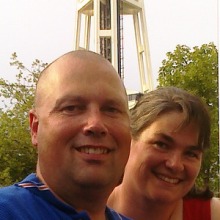Archive
Learning how to assess learning portfolios
David Wicks, Assistant Professor, Director of Instructional Technology, Seattle Pacific University
Andrew Lumpe, Professor, Associate Dean, School of Education, Seattle Pacific University
Abstract: When institutions switch from a program assessment system to individual learning portfolios, students spend more time reflecting upon, personalizing, and documenting their work. During such a transition, assessment design becomes more challenging. Alignment of artifacts to program standards is essential to ensure continuity of learning and program documentation. We describe a transition from a sterile electronic portfolio system to a learner centered, reflective blogging portfolio (bPortfolio) using free WordPress.com accounts. Session attendees will receive access to examples of portfolio entries, assessment rubrics, and strategies for using four types.
Presented at the 3rd Annual Emerging Technologies for Online Learning Symposium in San Jose, California on July 22, 2010.
Ten Etiquette Twips for Conference Tweeters
After attended several conferences this year where tweeting was not only allowed but encouraged, I thought that it might be helpful to develop some “twips” for tweeting at a conference. More than anything, this list was created to help me reflect on how I can be a more productive member of the community at this year’s MERLOT International Conference in San Jose.
- Be courteous to those sitting around you. Even at a technology conference, there are attendees who are distracted by the use of laptops and smart phones.
- Send only one or two Updates from a session. Share a twugget not a twanscript.
- Use Updates to ask any questions you have about a session topic or the conference in general. There are no quotos on inquiry-based Updates.
- Answer other participants questions using @username in Replies so the person asking a question can see the response under Mentions or @username.
- Include URLs to important content shared by presenters in your Updates. Be sure to use a URL shortening application (e.g. http:// tinyurl.com) to reduce the total number of characters.
- Include the conference hash tag, (e.g. #MIC09) on all conference-relate Updates to help others find and organize content for their Personal Learning Networks.
- Retweet (RT) valuable Updates from other participants letting the Twitterverse know that an important idea has been shared.
- Write concise updates. It’s hard to ReTweet Updates that use all or most of the 140-character limit.
- Avoid writing cryptic Updates. Texting is for kids.
- Golden Twip: Tweet only what is appropriate to stand and say during a conference session. A critique of a presenter’s delivery skills (e.g. “David Wicks is just reading his slides. Boring!”) should be saved for the official session evaluation form.
Do you have any recommendations on changes that should be made to this list? I will be sharing it as part of pre-conference webinar, How to Twitter about the MERLOT International Conference.
Happy tweeting at your next conference!
David
@dwicksspu
Take good care of your digital dossier
This YouTube video from the Digital Natives project can help students and teachers better understand how everything they are doing online is creating a digital finger print or tattoo that can be used later by someone who wants to know more about them. We need to think carefully before adding our personal thoughts and content online.
(delicious tags: higher_education web2.0 K-12 digital_native)
Learning with Facebook
The Chemistry of Facebook: Using Social Networking to Create an Online Community for the Organic Chemistry Laboratory 
This article reports on a study where students in a face-to-face course were given options of using facebook or WebCT to discuss course topics. The results show that the facebook group had a higher number of student posts that the discussion forums in WebCT. The researchers encourage others to consider social networking applications as a way to supplement instruction in face-to-face courses.
(delicious tags: Blackboard Facebook LMS higher_education)
Facebook grows older
Facebook’s demographics are changing as older people begin using it to connect with family and friends.
Practicing what you preach about open content
Handbook of Emerging Technologies for Learning 
The University of Manitoba uses a wiki as an online textbook for their Emerging Technolgies for Learning certification program. I like how they are practicing what they preach about the use of open source technology.
Is Google making us stupid? – The response
Response to Nicholas Carr Article Is Google Making Us Stupid 
Trent Batson defends Google and Web 2.0 technologies in his response to the popular Nicholas Carr aricle “Is Google Making Us Stupid?”

